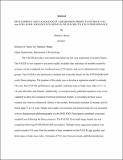DEVELOPMENT AND VALIDATION OF A REGRESSION MODEL TO ESTIMATE VO2 max FOR OLDER ADOLESCENTS FROM PACER 20-M SHUTTLE RUN PERFORMANCE
Author
Hanna, Matthew
Abstract
The PACER provides a convenient and relatively low cost assessment of aerobic fitness. The PACER is less expensive and more readily available than stationary or portable metabolic systems, can be completed in a condensed area of 20 meters, and can be administered to large groups. The PACER is the preferred (or default) test of aerobic fitness for the FITNESSGRAM[registered] youth fitness program. The purpose of this study was to develop a regression model to estimate VO₂ max from PACER performance, age, gender, and body mass or body mass index in 17- to 18-year-old males and females. Additionally, several previously published equations were cross-validated to allow for comparison between prediction models. A secondary purpose was to examine the criterion-referenced validity of the models. Participants included 22 females and 26 males aged 17 to 18 years. Height and weight were assessed and percent body fat was measured with air displacement plethesmography via the BOD POD. Participants completed a maximal treadmill test following the Bruce protocol. The PACER 20-m multi-stage shuttle run was completed following FITNESSGRAM[registered] procedures. Multiple linear regression analysis was used to predict VO₂ max from the number of laps completed on the PACER, age, gender, and body mass or body mass index. Estimates of VO₂ max from previously published prediction models were cross-validated and the standard error of estimate (SEE) and total error (TE) were calculated. Comparison of the two error estimates identified the effect of systematic overestimation or underestimation on prediction accuracy. Mean scores for VO₂ max for males (41.9 ± 9.9) and females (33.1 ± 6.7) were lower than the 2010 FITNESSGRAM[registered] Healthy Fitness Zone (HFZ) standards (males [greater-than or equal to] 44.2 ml.kg-1.min-1 and females [greater-than or equal to] 38.6 ml.kg-1.min-1). Only 27% of female participants (n = 6) and 42% of male participants (n = 11) had a measured VO₂ in the HFZ. The only variable that significantly contributed to estimation of VO₂ max was PACER laps completed. The model developed on the current sample was: VO₂ max = 20.41012 + (PACER laps * 0.41304). The correlation between measured VO₂ max and VO₂ max predicted from this equation was high (R = .89). All cross-validated prediction equations produced high correlations between measured and estimated VO₂ max (R [greater-than or equal to] .81). The prediction model developed in the current study and the Léger et al. (1988) model produced the highest correlations (r = .89) between measured and estimated VO₂ max, the lowest standard errors of estimate (4.36 ml.kg-1.min-1 and 4.43 ml.kg-1.min-1), and the lowest TE (4.36 ml.kg-1.min-1 and 4.81 ml.kg-1.min-1). Criterion-referenced analysis was used to examine the classification accuracy of the models for three categories (HFZ, Needs Improvement - Some Risk [NISR], and Needs Improvement - High Risk [NIHR]) and two categories (HFZ and Needs Improvement [NI]). Proportion of agreement for the three category analysis was moderate (Pa = .73) for the model developed in the current study. When classification was condensed into two classification zones (HFZ and NI), Pa increased (Pa = .88). The remaining cross-validated models had a low to moderate Pa (.52 - .66) under the three category format, and moderate Pa (.66 - .77) under the two category format. In conclusion, the prediction model developed in the current study developed on an older adolescent sample provides an accurate estimate of VO₂ max. The variable of laps completed on the PACER was the only significant contributor to the equation. Most of the previously published equations were notably less accurate than this new model. The current prediction model also produced accurate classification of fitness levels into the Healthy Fitness Zone or Needs Improvement categories.
Date
2017-09-27
Citation:
APA:
Hanna, Matthew.
(September 2017).
DEVELOPMENT AND VALIDATION OF A REGRESSION MODEL TO ESTIMATE VO2 max FOR OLDER ADOLESCENTS FROM PACER 20-M SHUTTLE RUN PERFORMANCE
(Master's Thesis, East Carolina University). Retrieved from the Scholarship.
(http://hdl.handle.net/10342/6476.)
MLA:
Hanna, Matthew.
DEVELOPMENT AND VALIDATION OF A REGRESSION MODEL TO ESTIMATE VO2 max FOR OLDER ADOLESCENTS FROM PACER 20-M SHUTTLE RUN PERFORMANCE.
Master's Thesis. East Carolina University,
September 2017. The Scholarship.
http://hdl.handle.net/10342/6476.
June 29, 2024.
Chicago:
Hanna, Matthew,
“DEVELOPMENT AND VALIDATION OF A REGRESSION MODEL TO ESTIMATE VO2 max FOR OLDER ADOLESCENTS FROM PACER 20-M SHUTTLE RUN PERFORMANCE”
(Master's Thesis., East Carolina University,
September 2017).
AMA:
Hanna, Matthew.
DEVELOPMENT AND VALIDATION OF A REGRESSION MODEL TO ESTIMATE VO2 max FOR OLDER ADOLESCENTS FROM PACER 20-M SHUTTLE RUN PERFORMANCE
[Master's Thesis]. Greenville, NC: East Carolina University;
September 2017.
Collections
Publisher
East Carolina University

